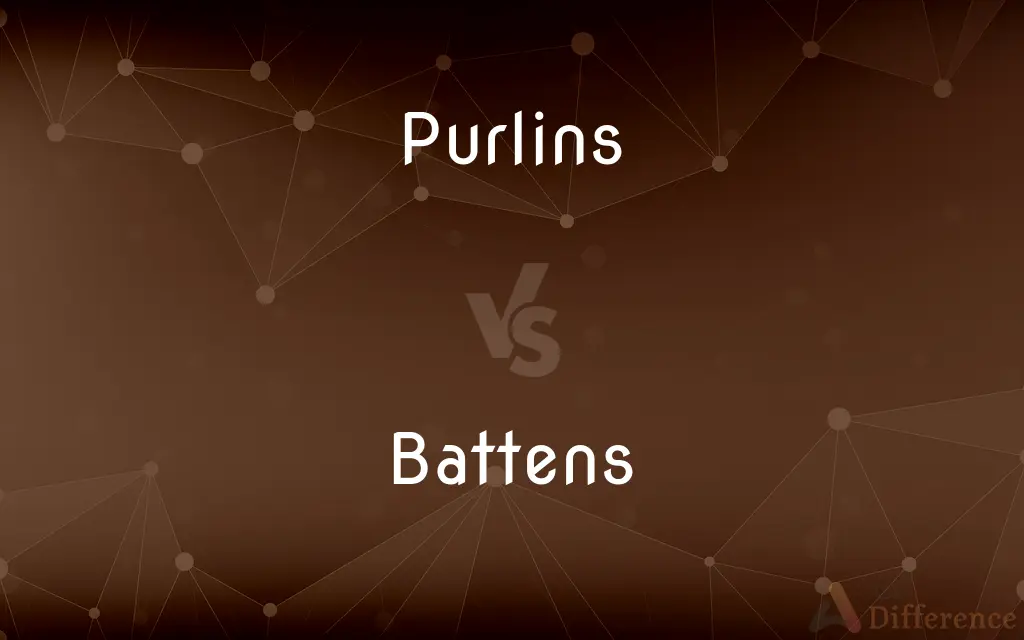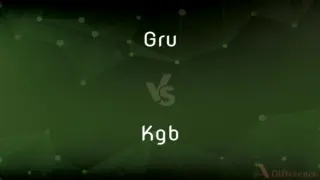Purlins vs. Battens — What's the Difference?
By Urooj Arif & Maham Liaqat — Updated on March 19, 2024
Purlins are horizontal structural members in a roof, supporting loads from the roof deck or sheathing, while battens are narrow strips of material placed over the roof underlayment or insulation to provide a fixing point for roofing materials.

Difference Between Purlins and Battens
Table of Contents
ADVERTISEMENT
Key Differences
Purlins are key structural components in both traditional and modern roofing systems. They span across the rafters or the trusses, providing additional support and reducing the span of the roofing material. Battens, on the other hand, are much narrower strips of material, often wood, metal, or plastic, and serve a different purpose. In roofing, they are installed on top of the underlayment or insulation, providing a fixed point for roofing tiles or sheets.
Purlins are typically made from wood, steel, or other durable materials, depending on the construction requirements and are substantial in size to bear significant loads. In wall construction, battens can be used to create a void for insulation or to provide an even surface for cladding or plastering.
While purlins contribute significantly to the structural integrity of the roof by supporting the loads and transferring them to the primary frames, battens primarily serve as a secondary layer, offering a base for the outer roof material and aiding in ventilation and water drainage.
Battens can be affixed directly to the purlins or to the roof sheathing, depending on the roofing structure. This setup allows for an air gap between the roofing material and the sheathing, promoting airflow and reducing moisture buildup, which is crucial for the longevity of roofing components.
The choice between using purlins or battens, or both, depends on the type of roofing system, the materials used, and the specific architectural requirements. While purlins are essential for structural support, battens play a crucial role in the placement and durability of the roof's outer layer.
ADVERTISEMENT
Comparison Chart
Function
Provide structural support to the roof covering
Offer a fixing point for roofing materials or tiles
Placement
Span across rafters or trusses
Affixed to the roof sheathing or purlins
Material
Wood, steel, other durable materials
Wood, metal, plastic
Role in Roofing
Support loads, reduce roofing material span
Facilitate tile attachment, aid in ventilation
Size
Larger, substantial for load-bearing
Narrower strips
Compare with Definitions
Purlins
Horizontal beams that provide support to the roof deck or sheathing.
The engineer calculated the required size of the purlins to ensure the roof could withstand heavy snowfall.
Battens
Provide a base for attaching various roofing materials.
Metal battens were installed to secure the corrugated roofing sheets.
Purlins
Part of the secondary framework in a roofing system.
The carpenters fitted the purlins into the roof framework before laying the insulation.
Battens
Narrow strips used to hold roofing tiles in place.
The roofer nailed the battens across the roof's surface to prepare for tile installation.
Purlins
Reduce the span of the roof covering, thus requiring less material strength.
The inclusion of purlins in the roof design allowed for the use of a lighter, more economical roofing material.
Battens
Also used in wall construction to even out surfaces or create a cavity for insulation.
Wall battens were installed to provide a level surface for the plasterboard.
Purlins
Aid in distributing the load of the roof covering to the primary structure.
By installing additional purlins, they improved the load distribution across the wider span of the roof.
Battens
Help create an air gap for ventilation under the roof covering.
The strategic placement of battens contributed to effective roof ventilation, extending the life of the roofing materials.
Purlins
Made from a variety of materials to match the structural needs.
Steel purlins were chosen for the industrial building due to their strength and durability.
Battens
Aid in moisture management by allowing water to drain away.
The battens were spaced to ensure proper drainage of rainwater, preventing water accumulation.
Purlins
One of several horizontal timbers supporting the rafters of a roof.
Battens
To become fat.
Purlins
Plural of purlin
Battens
To thrive and prosper, especially at another's expense
"[She] battens like a leech on the lives of famous people, ... a professional retailer of falsehoods" (George F. Will).
Battens
To fatten; overfeed.
Battens
(Nautical) To furnish, fasten, or secure with battens
Battened down the hatch during the storm.
Battens
One of several flexible strips of wood or plastic placed in pockets at the outer edge of a sail to keep it flat.
Battens
A narrow strip of wood used to fasten down the edges of the material that covers hatches in foul weather.
Battens
A narrow strip of wood used in construction, especially to cover a seam between boards, as flooring material, or as a lath.
Battens
The heavy swinging bar on a loom that holds the reed and is pulled forward to pack down the weft.
Battens
A flat stick used in weaving by hand to separate the upper and lower threads of the warp and to tighten the weft.
Battens
Plural of batten
Common Curiosities
Can battens be used without purlins?
Battens can be used directly on the roof sheathing without purlins, particularly in simpler roofing systems or where purlins are not part of the structural design.
What determines the choice of material for purlins?
The choice of purlin material depends on factors like the roof's design, load requirements, and environmental conditions.
Are purlins necessary for all types of roofs?
Purlins are common in many roofing systems, especially where large spans or heavy roofing materials are involved, but not all roof designs require them.
Can battens improve roof insulation?
While battens themselves don't provide insulation, the air gap they create can enhance thermal performance and moisture management in the roofing system.
How do purlins and battens work together?
In some roofing systems, battens are affixed to purlins to provide a fixing point for the roof covering, combining structural support with a base for material attachment.
Can battens be used for non-tile roofing materials?
Yes, battens are also used for other roofing materials like metal sheets, where they provide a fixing point and support ventilation.
What role do purlins play in metal roofs?
In metal roofing systems, purlins provide support for the metal sheets and can also contribute to the structural integrity of the building.
Are there different types of purlins?
Yes, there are several types, including Z-purlins and C-purlins, which differ in shape and are commonly used in metal building systems.
Do battens need to be treated for outdoor use?
Yes, especially wooden battens, which are often treated to resist moisture, decay, and pests when used outdoors.
Do purlins extend the lifespan of a roof?
By providing structural support and reducing material span, purlins can contribute to the overall durability and lifespan of a roof.
How are purlins installed?
Purlins are installed horizontally across the roof trusses or rafters, secured with fasteners suitable for the chosen material.
How are battens sized and spaced?
The size and spacing of battens depend on the type of roofing material being used and the specific installation requirements.
Is it possible to retrofit battens for better roof ventilation?
Yes, in some cases, battens can be added or adjusted in an existing roof to improve ventilation and drainage.
Can the spacing of purlins affect roof strength?
Yes, the spacing between purlins must be carefully calculated based on the load requirements and the roofing material to ensure sufficient strength and stability.
Share Your Discovery

Previous Comparison
Gru vs. Kgb
Next Comparison
Libel vs. LibelistAuthor Spotlight
Written by
Urooj ArifUrooj is a skilled content writer at Ask Difference, known for her exceptional ability to simplify complex topics into engaging and informative content. With a passion for research and a flair for clear, concise writing, she consistently delivers articles that resonate with our diverse audience.
Co-written by
Maham Liaqat















































